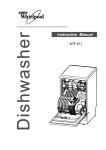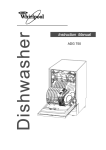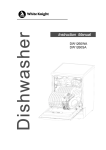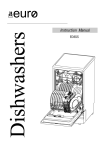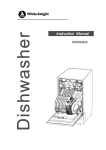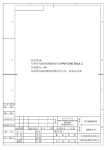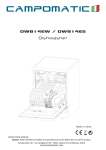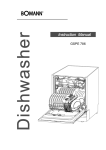Download Whirlpool ADG 175 Operating instructions
Transcript
ADG 175 Dear Customer, Please carefully read this manual before using the dishwasher, it will help you to use and maintain the dishwasher properly. Keep it to refer to it at a later date. Pass it on to any subsequent owner of the appliance. This manual contains sections on safety Instructions, Operating Instructions, Installation Instructions and Troubleshooting Tips, etc. Control Panel...................................................3 Dishwasher Features.................................... ...3 A、Water Softener...........................................4 B、Loading the Salt into the Softener.................5 C、Fill the Rinse Aid Dispenser.........................5 D、Function of Detergent .................................7 Attention before or after loading the Dishwasher Baskets..........................................................9 Loading the upper Basket.................................9 Loading the Lower Basket...............................10 Cutlery Basket........................................... ...11 Wash Cycle Table...........................................12 Turning on the Appliance...............................13 Change the Programme..................................13 At the End of the Wash Cycle...........................13 To review the section on troubleshooting Tips will help you to solve some common problems by yourself . If you can not solve the problems by yourself , please ask for the help of professional technicians. Filtering System.............................................15 Caring for the Dishwasher...............................15 Please carefully read the installation instruction ..................................................................... 17 Aesthetic panel's dimensions and installation ....17 Tension adjustment of the door spring .............. 19 Connection of drain hoses.......................................19 Dishwasher installation steps..........................20 Water Connection...........................................22 The manufacturer, following a policy of constant development and updating of the product, may make modifications without giving prior notice. Before calling for service.................................23 Error codes...................................................24 Technical information.....................................25 When using your dishwasher, follow the precautions listed below: This appliance must be grounded. In the event of a malfunction or breakdown, grounding will reduce the risk of anelectric shock by providing a path of least resistance of electric current. This appliance is equipped with a cord having an equipmentgrounding conductor and a grounding plug. The plug must be plugged into an appropriate outlet that is installed and grounded in accordance with all local codes and ordinances. Do not abuse, sit on, or stand on the door or dish rack of the dishwasher. Do not operate your dishwasher unless all enclosure panels are properly in place. Open the door very carefully if the dishwasher is operating, there is a risk of water squirting out. Do not place any heavy objects on or stand on the door when it is open. The appliance could tip forward. When loading items to be washed: 1) Locate sharp items so that they are not likely to damage the door seal; 2) Warning: Knives and other ute nsils with sharp points must be loaded in the basket with their points down or p lace d in a horizonta l position. When using your dishwasher, you should prevent plastic items from comin g into contact with the heating element.(This instruction is only applicable to machines with a visual heating element.) Check that the detergent comparment is empty after completion of the wash cycle. Do not wash plastic items unless they are marked dishwasher safe or the equivalent. For plastic items not so marked, check the manufacturer's recommendations. Use only detergent and rinse additives designed for an automatic dishwasher. Never use soap, laundry de terg ent, or hand washing detergent in your dishwasher. Keep these products out of the re ach of children. 1 Improper connection of the equipment-grounding conductor can result in the risk of an electric shock. Check with a qualified electrician or service representative if you are in doubt whether the appliance is properly grounded. Do not modify the plug provided with the appliance; If it does not fit the outlet. Have a proper outlet installed by a qualified electrician. Keep children away from detergent and rinse aid, keep children away from the open door of the dishwasher, there could still be some detergent left inside. This appliance is not intended for use by persons (including children )with reduced physical, sensory or mental capabilities, or lack of experience and knowledge ,unless they have been given supervision or instruction concerning use of the appliance by a person responsible for their safety. Children should be supervised to ensure that they do not play with the appliance. Dishwasher deterge nts are strongly alkaline, they can be extremely da ngerous if swallowed. Avoid con tact with skin and eyes and keep children away from the dishwasher when the door is open. The door sh ould not be left o pen, since th is could increase the risk of tripping. If the supply cord is damaged, it must be replaced by the manufacturer or its service agent or a similarly qualified person in orde r to avoid a hazard. Remove the door to the washing compartment when removing an old dishwasher from service or discarding it. Please dispose of pack ing materials properly. Use the dishwasher only for its intended function. During installation, the power supply must not be exce ssiv ely or dangerously bent or flattened. Do not tamper with controls. The appliance is to be connected to the water mains u sing new hose sets and that old hose-sets sho uld not be reused. The maximum numb er of place settings to be washed is 9. The maximum permissible inlet water pressure is 1Mpa. The minimum permissible inlet water pressure is 0.04Mpa. Dispo se of the dishwasher packaging material correctly. All pa ckaging materials ca n be recycled. Plastic parts are marked with the standard international abbreviations: PE for polyethylene, e .g. sheet wrapping material PS for polysty rene, e.g. padding material POM PP ABS po lyoxymethylene, e.g. pla stic clips polypropylene, e.g. Salt filler Acrylonitrile Butadiene Styrene, e.g. Control Panel . WARNING! Pa ckaging material could be dangerous for children! For disposing of package and the a ppliance ple ase go to a recycling cen tre. Therefore cut off the power s upply cable and mak e the door closin g device unusable. Cardboard packaging is manufactured from recycled paper and should be dispos ed in the waste paper collection for recycling . By ensuring this product is disposed of correctly, you will help prevent potential n egative consequences for the environment and human health, which could otherwise be caused by inappropriate waste han dling of this prod uct. For more detailed information about rec ycling of this product, please con tact your local city office and your household waste disposal service. DISPOSAL: Do not dispose this product as unsorted municipal waste. Collection of such waste separately for special treatment is necessary. 2 To get the best performance from your dishwasher, read all operating instructions before using it for the first time. 1 Program indicator light: when you select washing program, the corr espond light will display. 6 3in1 indicator lig ht / 3in1 functions Button: To select and show 3in 1 2 Program Key-press:To sel ect washing progr am when press the Key-press. 7 3 Powe r light: To co me on when Power ON/OFF button is pressed down. Salt and Rinse Aid Warning Light: To come on when the softener or dispenser needs to be refilled. 8 ON/OFF Button: To turn on/off the power supply. 4 5 Display: To display delay time or error codes. Delayed Start Button: Press this button to set the delayed hours for washing. You can delay the start of washing up to 24 hours. One press on this button delays the start of washing by one hour. Back View Front view 7 1 2 3 8 4 5 9 6 10 11 12 13 on O ff 1 2 3 4 Upper Basket Spray Arms Lower Basket Sa lt Container 5 6 7 8 Main Filter Detergent Dispenser Cup Shelf Cutlery Basket 3 9 10 11 12 Coarse Filter Rinse Aid Dispen ser Drain pipe connector Inlet pipe connector 13 Tray ass Before using your dishwasher for the first time: A. Set the water softener B. Pour 1/2 litre of water inside the salt container and then fill with d ishwash er salt C. Fill the rinse aid dispenser D. Fill in detergent A. Water Softener The water softener must be set manually, using the water hardness dial. The water softener is designed to remove minerals and salts from the water, which would have a detrimental or adverse effect on the operation of the appliance. The h igher the content of these minerals and salts, the harder your water is. The softener should be adjusted according to the hardness of the water in you r area. Your local Water Authority can advise you on the hardness o f the water in your area. Adjusting Salt Consumption The dishwasher is designed to allow for adjustment in the amount of sa lt co nsumed bas ed on the ha rdness of the water used. This is intended to optimise and customise the level o f salt consumption. Please follow the steps below for a djustmen t in salt consumption. 1. Unscrew the cap from the salt container. 2. There is a ring on the container with an arrow on it (see figure on the side), if necessary, ro tate the ring in the anticlockwise dire ction fro m th e "-" Setting toward the "+" sign, based on the hardness o f the water being used. It is recommended that adjustme nts should be made in accordance with the following scheme: WATER HARDNESS dH fH Clarke mmol/l Selector Position Salt consumption (gram/cycle) Auto nomy (cycles/1kgs) 0~8 0~14 0~10 0~1.4 / 0 / 8~22 14~39 10~28 1.4~3.9 - 20 50 22~45 39~80 28~56 3.9~8 Mid 40 25 8~11 + 60 16 45~60 Note:1 80~107 °dH=1.25 56~75 °Clarke=1.78 °fH=0.178mmol/l °DH: German degree °fH: French degree Note:2 " /" "-" "+" "Mid" ° Clark: British degree No salt need added Setting toward the"-" sign Setting toward the"+" sign Setting toward between the "-" sign and "+" sign Contact your local water board for information on the hardness of your water supply. 4 B. Loading the Salt Into the Softener Always use the salt intended for use with dishwasher. The salt contain er is located beneath the lower basket and should be fill ed as explained in the following: Attention! Only use salt spe cif ically desi gne d for t he use i n dishwashers! Every other type of salt not speci fically de sig ned fo r the u se in a d ishwasher, espe cially table salt, will damage the w ater sof tener. In case of damages caused by the use of unsuitable salt the ma nuf act urer does not give any wa rranty nor is liable for any damages caused. Only fil l wi th salt just b efore starting one of the co mp let e washing p rograms. This wi ll prevent any g rains of salt or salty wate r, which ma y have been spilled, remaining on the bottom of the machi ne for any period of time, which may cause corrosi on. A Remove the lower basket and then unscrew and remove the cap from the salt container. B Before the first wash, fill 1lt. of water in the salt container of your machine. C Place the end of the funnel (supplied) into the hole and introduce about 1kg of salt. It is normal for a small amount of water to come out of the salt container. D After filling the container , screw the cap tightly back clockwise. E Usually, the salt warning light will stop being illuminated within 2-6 days after the salt container has been filled with salt. F Immediately after filling the salt into the salt container, a washing program should be started (We suggest to use the soak or rapid program). Otherwise the filter system, pump or other important parts of the machine may be damaged by salty water. This is out of warranty. 1. The salt container must only be refilled when the salt warning light in the control panel comes on. Depending on how well the salt dissolve s, the salt warning light may still be on even though the salt container is filled. If there is no salt warning light in the con trol panel (for some Mode ls),you can estimate when to fill the salt into the softener by the cycles that the dishwasher has run. 2. If there are spills of the salt, a soak or a rapid program should be run to remove the excessive sa lt. C. Fill the Rinse Aid Dispenser Rinse Aid Dispenser The rinse aid is released during the final rinse to prevent water from forming droplets on your dishes, which can leave spots and streaks. It also improves drying by allowing water to roll off the dishes. Your dishwasher is designed to use liquid rinse aids. The rinse aid dispenser is located inside the door next to the detergent dispenser. To fill the dispenser, open the cap and pour the rinse aid into the dispenser until the level indicator turns completely black. The volume of the rins e aid container is about 110ml. Function of Rinse Aid Rinse aid is automatically added during the last rinse, ensuring thorough rinsing, and spot and streak free drying. Attention! Only use branded rinse aid for dishwasher. Never fill the rinse aid dispenser with any other substances (e.g. Dishwasher cleaning agent, liquid detergent). This would damage the appliance. 5 When to Refill the Rinse Aid Dispenser If there is no rinse-aid warning light in the control panel, you can estimate the amount from the colour of the optical level indicator " C "located next to the cap. When th e rinse-aid container is full, the whole indicator will be dark .As the rinse -aid diminishes, the size of the dark dot decreases. You should never let the rinse aid leve l fall 1 / 4 full. C (Rinse-Aid indicator) As the rinse aid d iminishes, the size o f the black dot on the rinse aid level indicator changes, as illustra ted below. Full 3 / 4 full 1 / 2 full 1 / 4 full - Should refill to eliminate spotting Empty 1 2 3 6 To open the dispenser, turn the cap to the "open" (left) arrow and lift it out. Pour the rinse aid into the dispenser, being careful not to overfill. Replace the cap by inserting it aligned with "open" arrow and turning it to the closed (right) arrow. Clean up any rinse aid spilled while during filling with an absorbent cloth to avoid excessive foaming during the next wash. Don't forget to replace the cap before you close dis hwa sher door. Adjusting Rinse Aid Dispenser The rinse aid dispenser has six or four settings. Always start with the dispenser set on "4". If spots and poor drying are a p roblem, increase the amount of rinse aid dispensed by removing the dispenser lid and rotating the dial to "5". If the dishes still are not drying properly or are show spots, adjust the dial to the next higher lever until your dishes are spot-free. The recommended setting is "4". (Factory value is "4".) Adjust lever (Rinse) NOTE: Increase the dose if there are drops of water or lime spots on the dishes after washing. Reduce it if there are sticky whitis h stains on your dishes or a bluish film on glassware or knife blades. D. Function of Detergent Detergents with its chemical ingredients are necessary to remove dirt, crush dirt and transport it out of the dishwasher. Most of the commercial quality deterge nts are suitable for this purpose. Detergents There are 3 sorts of d etergents 1.With phosphate and with ch lorine 2.With phosphate and without chlorine 3.Without phosphate and without chlorine 6 Normally new pulverised detergent is with out phosphate. Thus the water softener function of phosphate is not given. In this case we recommend to fill salt in the salt con taine r even when the hardness of water is only 6 °dH. If dete rgents witho ut phosphate are used in the case of hard water often white spots appear on d ishes and glasses. In this case please add more detergent to reach better results. Detergents without chlorine do only bleach a little. Stron g and coloured spots will not be removed completely. In this case please choose a program with a higher temperature. Concentrated Detergent Based on their chemical composition, deterge nts can be split in two basic types: conventional, alkaline dete rgents with caus tic comp onents low alkalin e co ncentrated detergen ts with n atural enzymes The use of“normal” washing progra ms in combination with concentrated detergen ts reduces pollution and is good for your dishes; these wash p rograms are specifically matche d to the dirt-dissolving properties o f the enzymes of the concentrated de terg ent. For this reason “normal”wash programs in which conce ntrated detergents are used can achie ve the same results that c an otherwise only be ach ieved using “intensive” programs. Detergent Tablets Detergent tablets of diffe rent brands disso lve at different speeds. For this reason some detergent tablets cannot dissolve and develop the ir full cleaning power during short programs. There fore please use long programs wh en u sin g deterg ent tablets, to ensure the complete removal of detergent residua ls. Detergent Dispenser The dispenser must be refilled before the start of each wash cycle following the instructions provided in the wash cycle table . Your dis hwa sher uses less de tergent and rinse aid than Conventional dis hwa sher. Generally, only one tablespoon of detergent is needed for a normal wash load. More heavily soiled items need more detergent. Alway s ad d the detergent just be fore starting the dish was her, otherwise it could get damp and will not dissolve properly. Amount of Detergent to Use If the lid is closed: press release button. T he lid will sp ring open. Always add the detergent just before starting each wash cycle. Only use branded detergent aid for dishwasher. WARNING! Dishwasher detergent is corrosive! Take care to keep it out of reach of c hildren. Prop er Use of De terg ent Use only deterge nt specifically made for the use in dishwashers. Keep your detergent fresh and dry. Don't put powdered d etergent into the dispenser until you're ready to wash dishes. 7 Fill in Detergent Fill the detergent dispenser with detergent. The marking indicate s the dosing levels , as illustrate d on the righ t: A B 6 The place of main wash cycle deterg ent placed , “MIN”me ans approximately 20g of detergent. The place of pre-wash cycle deterge nt placed , approximately 5g o f detergent Plea se o bserve the manufacturers dosing and storage Recommendations as stated on the detergent packaging. Close the lid and press until it locks in place. If the dishes are heavily soiled, place an additional detergent do se in the pre-wash detergent chamber. This detergent will take effect during the pre-wash phas e. You find information about the amount o f detergent for th e single programme on the last page . Please aware, tha t according to the level soiling and the specific hardness of water differences are possible. Please observe th e manufacturer's rec ommendations on the de tergent packaging. How To Use The 3IN1 Function Your dishwasher has a 3in1 function which needs no salt and rinse aid but a 3In1 tablet. This dishwasher comes with a 3in 1 tablet container as an accessory. Only the 3in1 fun ction(for the program: intensive/Normal/Eco.) Can be used with 3in1 tablets. If you use 3in1 ta blets in other programs, the appliance will not achieve a good performance. 1. The figure below shows how to hang the 3in1 tablet container on the upper basket. 2. Rotate the up per sprayer an d ch ange the location of the container to ensure the upper sprayer is not obstructed by the 3in 1 tablet container. Refer to the figure below for reference. 3. Put the 3in1 tablet into the container ,then start the 3in1 pro gram. When using 3in1 combination / compact Detergents ,please pay attention to make sure that the size of the combination detergents fits to the dispenser,so that combination detergents can be ea sily put into the dispenser, and the dispenser would not be broken. 8 For best performance of the dishwasher, follow these loading guidelines. Features and appearance of baskets and cutlery baskets may vary from your model. Attention before or after Loading the Dishwasher Baskets Scrape off any large amounts of leftover food. Soften remnants of burnt food in pans. It is not necessary to rinse the dishes under running water. Place objects in the dishwasher in following way: 1.Items such as cups, glasses, pots/pans, etc. are faced downwards. 2.Curved items, or ones with recesses, should be loaded aslant so that water can run off. 3.All utensils are stacked securely and can not tip over. 4.All utensils are placed in the way tha t the spray arms can rotate freely during washing. Very small items should not be washed in the dishwasher as they could easily fall ou t of the baskets. Loading the Upper Rack The upper rack is designed to hold more d elicate and lighter dishware such as glasses, coffee and tea cup and saucers, as well as plates, small bowls and shallow pans (as long as they are not too dirty). Position the dishes and cookware so that they do not get moved by the spray of water. Bowl(M) Bowl( L) Cups Gravy ladle Glasses Dessert plate Saucers Front (Eg g) Adjusting the Upper Basket The height of the upper basket can be adjusted in order to create more space for large utensils both for the upper/lower basket. The height of the upper basket can be adjusted by placing the wheels on different height of the rails. Long items, serving cutlery, salad servers and knives should be placed on the shelf so that they do not o bstruct the rotation of the spray arms. The shelf can be fold ed back or be removed when not required for use. Upper wheels Lower wheels 9 Loading the Lower Basket We recommend that you p lace large items which are most difficult to clean into the lower basket: pots, pans, lid s, serving dishes and bowls, as s hown in the figure to the right. It is preferable to place serving dishes and lids on the side of the racks in order to avoid blocking the ro tation of the top spray arm. Pots, serving bowls, etc. must always be placed top down. Deep pots should be s lanted to allow water to flow out. The bottom basket feature fold down tine rows so that larger or more pots and pans can be lo aded . 1. Cutlery basket 2. Dessert plates 3. Soup plates 4. Dinner plates 5. Oval platter 6. Saucer 10 Cutlery Basket Cutlery should be placed in the cutlery basket with the handles at the bottom. If the rack has side baskets, the spoons should be loaded separately into the appropriate slots, especially long utensils should be placed in the horizontal position at the fron t of the uppe r basket as s hown in the picture. 3 5 5 3 1 5 5 1 3 5 5 3 3 5 5 3 1 5 6 1 3 2 1 3 3 2 4 4 1 2 4 4 2 2 4 4 2 2 1 4 1 2 1 4 7 2 7 4 1 1. 2. 3. 4. 5. 6. 7. 2 3 4 5 6 7 Tea spoons Dessert spoons Soup spoons Forks Knives Serving forks Serving spoons Do not leave any item extend thro ugh bottom. Knives and other utensils with sharp points must be loaded in th e basket with their points down or placed in an horizontal position. Always load sharp utensils with the sharp point down! For washing in th e dishwashe r the following cutlery/dishes Are not suitable Are of limited suitability Cutlery with wooden, horn china or mother-of-pearl handles Plastic items that are not heat resistant Older cutlery with glued parts that are not temperature resistant Bond ed cutlery items or dishes Pewter or cooper items Crystal glass Steel items subject to rusting Wooden platters Items made from synthetic fibres Some types of glasses can become dull afte r a large numbe r of washes Silver and aluminum parts have a tendenc y to discolour du ring washin g Glazed patterns may fade if machine washed freq uently NOTE: Do not put in items that are dirty of cigarette ash, c andle wax, lacquer or paint. If you buy new dishes please make sure that they are suitable for dishwashers. NOTE: Plea se do no t overload your dishwash er. There is only space for 9 standard dishes. Do not use dish that is no t suitable for dishwa shers. This is important for good resu lts and for reasonable e nergy consu me. Loading cutlery and dishes Before loading the dishes, you should: Remove large left-over Softe n re mnants of burnt food in pans When loading the dishes and cutlery, please note: Dishes and cutlery must n ot imped e th e rotation of the spray arms Load hollow items such as cup s, glass es, pans etc. with the opening downwards so that water cannot collect in the con tain er or a deep base It is dangerous to open the door when washing, b ecause the hot water may be scalded to y ou. The door should not be left in the open position since this could present a trip ping hazard. 11 ( ) Meaning: need to fill rinse into the Rinse-Aid Dispenser. *En50242: This program is the test cycle, the rinse-aid dispenser setting is recommended to be set to position 6. Intensive For the heaviest soiled loa ds, such as pots, pans, ca sserole dishes and dishe s that have been sitting with dried food on them for a while. Daily For normally soiled loads, such as pots , p lates,glasse s and lig htly soiled pan s. Stan dard daily cycle. EN 50242 Express Delicate 5/2 2g 173 1.4 18.4 Pre-wash Wash (50 ℃) Rinse (60 ℃) Drying 5/22g 171 0.81 13.0 98 0.8 8.0 22g 111 0.7 11.0 For dishes that need to be rinsed and dried only. Wash(45℃) Rinse (70 ℃) Drying For lightly soiled loads,such as plates,glasses,bowls and lightly soiled pans. Pre-wash Wash (45 ℃) Rinse (60 ℃) Drying Sani rinse Eco. Pre-wash(5 0℃ ) Pre -wash Wash (60 ℃) Rinse Rinse Rinse (70 ℃) Drying A shorter wash for lightly soiled loads that do not need d rying. Wash (40 ℃) Rinse (45 ℃) 15g 28 0.35 7.0 For lightly soiled loads, such as glasses, crysta l and fine ch ina. Pre-wash Wash (40 ℃) Rinse (70 ℃) Drying 15g 118 0.8 11.0 11 0.01 6.0 To rinse dishes that you plan to wash later that day. Pre-wash Pre -wash + Intensive + 3in1 + Daily + 3in1 + Eco. + 3in1 For the heaviest soiled loads, such as pots, pans, casserole dishes and dishes that have been sitting with d ried food on them for a while. Pre-wash(60℃) Wash (70 ℃) Rinse Rinse Rinse (70 ℃) Drying 3in1 161 1.5 15.1 For normally soiled loads, such as pots , plates, glasses and lightly soiled pans. standard daily cycle . Pre-wash Wash (50 ℃) Rinse (70 ℃) Drying 3in1 148 1.0 12.7 3in1 128 0.8 12.7 Pre-wash For lightly soiled loads,such Wash (45 ℃ ) as plates,glasses,bowls and Rinse (70 ℃) lightly soiled pan s. Drying 12 Turning On the Appliance Starting a cycle wash 1 Draw out the lower and up per basket, load the dish es a nd push them back. It is commended to lo ad the lower basket first, then the upper o ne (s ee the section e ntitled “Loading the Dishwashe r”). 2 Pour in the d etergent (see the section entitled“Salt, Detergent and Rinse Aid”). 3 Insert the plug in to the socket. The power supply is 220-240 VAC /50 HZ , the specification of the socket is 10A 25 0VAC. Make sure that the wa ter supply is turned on to full pressure. 4 Ope n the doo r, p ress the ON/OFF button, and the ON/OFF light will turn on. Press the progra m button to a sired wash cycle. and close th e d oor . After 3 seconds, the machine will work. Change the Program... Premise: 1. A cycle that is underway can only be modified if it has on ly been running for a short time. Otherwise, the detergent may have already been released, and the appliance may have already drained the wash water. If this is the case, the detergen t dispenser must be refilled (see the s ection entitled " Loading the Detergent " ). 2. Pre ss current prog. Button more tha n 3 seconds to cancel the program , then you can change the program to the desired cycle setting (see the section entitled " Starting a wash cycle. . . " ). 3. Pre ss one of others prog. Button more than 3 seconds to cancel the runing program , translase the program which you press. 4. Pre ss the display button more tha n 3 seconds to re-edit disp lay time . Forgot to Add a Dish? A forgotten dish can be added at any time before the detergent cup opens. 1 2 Open the door a little to stop the washing. 3 Load the forgotten dishes. After the spray arms stop working,you can open the door completely. 4 Close the door, the dishwasher will start running again after 10 seconds. At the End of the Wash Cycle When the wo rking cycle has finished, the buzzer of the dishwasher will sound for 8 seconds, the n stop. Turn off the appliance using the ON/OFF button, shut off the water supply and open the door of the dishwasher. Wait for a few minutes before unlo ading th e dishwasher to avoid ha ndling the dishes and utensils while they are still hot and more susceptible to break age. They will also d ry better. Switch Off the Dishwasher Th e buzzer of the dishwasher moos for 8 secon ds, o nly in this ca se the programme has ended . 1.Switch o ff the dishwasher by pressing the ON/OFF bu tton. 2.Turn off the water tap! Open the door carefully. Hot dishes are sensitive to knocks. The dishes should therefore be a llowed to cool down around 15 minutes before removing from the appliance. Open the dishwasher's door, leave it ajar and wait a few minutes before removing the dishes. In this way they will be cooler and the drying will be improved. Unloading the dishwasher It is normal that the dishwasher is wet insid e. Empty the lower basket first and then the upper one. This will avoid water dripping fro m the upper Bas ket onto the dishes in the lower one. WARNING! It is dangerous to open the door when washing, because the hot water may scald you. 13 Filtering System The filter prevents larger remnants of food or other objects from getting inside the pum. The residues may block the filter, in this case they must be removed. The filter system consists of a coarse filter,a flat (Main filter) And a microfilter(Fine filter). Main filter 2 1 Fo od and soil particles trap ped in this filter are pulverized by a specia l jet on the lower spray arm and washed down to drain. 1 Coarse filter 2 La rger ite ms, such as p ieces of bones or glass, that could block the drain are trapped in the coarse filter. To remove the items caught by the filter, gently squeeze the tap on the top of this filter and lift out. 3 Fine filter 3 This filter holds soil and food residues in the sump area a nd preve nts it from being redeposit on the dishes during wa sh cycle. Filter assembly The filter efficiently re mo ves food particle s from the wash water, allowing it to be rec ycled during the cycle. For best performance and results, the filter must be cleaned re gularly. For this reason, it is a goo d idea to remove the larger food particles trapp ed in the filter after e ach was h cycle by rinsing the semicircular filter and cup under runnin g water. To remove the filter device, pull the cup handle in the upward d irection. WARNING! The d ishwasher must never b e used without the filters. Improper replacement of the filter may reduce the performance level of the appliance and damage dishes and utensils. Step 1:Turn the filter in anti-clockwise direction, then lift it u p. Step 2:lift the Main filte r up Step 3: lift the F ine filter up When following this procedure from step1 to step 3, the filter system will be removed; when following it from Step 3 to Step 1, the filter system will be installed. 14 Remarks: - Inspect the filters for blo cking a fter e very time the dishwa sher has been used. - By unscrewing the coarse filter, you can remove the filter system. Re move any foo d remna nts and clean the filters under running water. The entire filter assembly should be cleaned once a week. Cleaning the Filter To clean the coarse filter and the fine filter, use a c leaning b rush. Reassemb le the filter p arts as shown in the figures on the last page and reinsert the entire assembly in the dis hwa sher, positio ning it in its seat and pressing downwards. WARNING! When cleaning the filters, don't knock on them. Otherwise, the filters could be contorted and the performance of the dishwasher could be decreased. Caring for the Dishwasher The control panel can be cleaned by using a lightly dampened cloth. After cleaning, make sure to dry it thoroughly. For the exterior, use a good appliance polish wax. Never use sharp objects, scouring pads or harsh cleaners on any part of the dishwasher. Cleaning The Door To clean the e dge around the door, you should use only a soft warm, damp cloth. To avoid pene tration o f wa ter into the door lock and electrical components, do not use a spray cleaner of any kind. WARNING! Never use a spray cleaner to clean the door panel as it may damage the door loc k and electrical components. Abrasive agents or some paper towels shou ld not be used becau se of the risk of scratching or leaving spots on the stainless steel surface. Protect Against Freezing please take frost protection measures on the dishwasher in winter. Every time a fter washing cycles, please operate as follows: 1.Cut off the electrical power to the dishwasher. 2.Turn off the water supply and disconnect the water inlet pipe from the water valve. 3.Drain the water from the inlet pipe an d water valve. (Use a pan to catch the water) 4.Reconnect the water inlet pipe to the water valve. 5.Remove the filter at the bottom of the tub and use a sponge to soak up water in the sump. If your dishwasher cannot work because of the ice, please contact professional service person s. Cleaning the Spray Arms It is necessary to clean the spray arms regularly in order to remove the accumulation of scale from the hard water and thus prevent blocking of spray arm jets and bearings. We Suggest to poke the blocked spray arm jets with a needle to ensure good washing effect. 15 Unscrew After Every Wash When not in Use for a LongTime After every wash, turn off the water supply to the appliance and leave the door slightly open so that moisture and odours are not trapped inside. It is recommend that you run a was h cy cle with the dishwasher empty an d the n remove the plug from the socket, turn off the wa ter supply and leave the door of the appliance slightly open. This will help the d oor seals to last longer and prevent odours from forming within the appliance. Remove the Plug Before cleaning or performing maintenance, always remove the plug from the socket. Moving the Appliance No Solvents or Abrasive Cleaning To cle an the e xterior a nd rubber p arts of the dishwasher, do not use solvents or abrasive cle aning products. Only use a clo th with warm so apy water. To remove spots o r stains from the surface of the interior, use a cloth da mpened with water a n a little vinegar, o r a cleaning pro duct mad e specifically for dishwashers. Seals One of the factors that cause odours to form in the dishwasher is food that remains trapped in the seals. Periodic cleaning with a damp sponge will prevent this from occurring. Electrical Shock Hazard Disconnect electrical power before installing dishwasher. The installation of the pipes and electrical equipments should be done by professionals. ● If the appliance must be moved, try to keep it in the vertical position. If absolutely necessary, it can be positioned on its back. Failure to do so can result in death or electrical shock. Installation preparation The installation position of dishwasher should be near the existing inlet and drain hoses and power cord. One side of the cabinet sink should be chosen to facilitate the connection of drain hoses of the dishwasher. Note: please check the accompanying installation accessories(hook for aesthetic panel ,screw) 16 Please carefully read the installation instruction. ● Illustrations of cabinet dimensions and installation position of the dishwasher Preparations should b e made before moving the dishwasher to the installation place. Choose a place near the sink to facilitate the installation of inlet and drain hoses (see figure 1). If dishwasher is installed at the corner of the cabinet, there should be some sp ace (illustrated in figure 2) 1 2 when the door is o pened. 90 ° 【Figure1】 Cabinet dimensions Less than 5mm between the top of dishwasher and cabinet and the outer door aligned to cabinet. 90 ° 820mm 580mm Electrical, drain and water supply line entrances 80 100 Space between cabinet bottom and floor 450 mm Dishwasher 【Figure2】 Cabinet Minimum space when the door is opened Door of dishwasher Minimum space of 50mm ● Aesthetic panel's dimensions and installation 1 The aesthetic wooden panel could be processed according to the figure 3 390 15 3.5 【Figure3】 418 The aesthetic panel should be processed in accordance with the illustrated dimensions 38 19 52 175 179 444 (Unit: mm) 17 1.5 2 Install the hook on the aesthetic wooden panel and put the hook into the slot of the outer door dishwasher(see figure 4a). After positioning of the panel , fix the panel onto the outer door by screws and bolts(See figure 4b) . Hop hook 【Figure4a】 Installation of aesthetic panel St4 countersunk head screw Lower hook 4X18 screw 【Figure4b】 Cover Installation of aesthetic wooden panel Spacer for aesthetic panel 1. take away the cover 2. pin up the screw 3. get back the cover Hook for aesthetic panel Outer door of dishwasher 18 Aesthetic panel of ● Tension adjustment of the door spring The door springs are set at the factory to the proper tension for the outer door. If aesthetic wooden panel are installed, you will have to adjust the door spring tension. Rotate the adjusting screw to drive the adjustor to strain or relax the steel cable(see figure 5). Door spring tension is correct when the door remains horizontal in the fully opened position,yet rises to a close with the slight lift of a finger. rel ax 【Figure5】 Tension adjustment of the door spring ● Connection of drain hoses Insert the drain hose into a drain pipe with a minimum diameter of 4cm, or let it run into the sink, making sure to avoid bending or crimping it. Use the spe c ial plastic support that comes with the appliance (figure 6). The free and of the hose must be at a height between 400 and 1000mm and must not be immersed in water to avoid the back flow of it. ATTENTION: The special plastic hose support must be solidly fastened to the wall to prevent the drain hose from moving and allowing water to spill outside the drain. 【Figure6】 Drain pipe connection 19 ● Dishwasher installation steps 1 Install the furniture door to the outer door of the dishwasher using the brackets provided. Refer to the template for positioning of the brackets. 2 Adjust the tension of the door springs by using an Allen key turning in a clockwise motion to tighten the left and right door springs. Failure to do this could cause damage to your dishwasher (Illustration 2) . 3 Connect the inlet hose to the cold water supply . 4 Connect the drain hose. Refer to diagram . (Figure 6) 5 Connect the power cord . 6 Affix the condensation strip under the work surface of cabinet. Please ensure the condensation strip is flush with edge of work surface. 7 Place the dishwasher into position. 8 Level the dishwasher. The rear feet can be adjusted from the front of the dishwasher by turning the screws on the left and right hand side of the cabinet (Illustration 5A). To adjust the front feet, use a wrench and turn the front feet until the dishwasher is level (Illustration 5B). 9The dishwasher must be secured in place. There are two ways to do this: A. Normal work surface-secure to the work surface by using two woodscrews ensuring the dishwasher weight is not being hit by the surface (Illustration 6). B. Marble or granite work top-secure the bracket to the side panel of the dishwasher and secure the dishwasher to the furniture housing. Put the rubber cap over the screw (Illustration 7). 2 6 4 SCREW CONE GEAR 5A 5B 5 RUBBERCOVER 7 SCREW 【Figure 7】 20 Dishwasher must be level for proper dish rack operation and wash performance. 1 Place level on door and rack track inside the tub as shown to check that the dishwasher is level. 2 level the dishwasher by adjusting the four leveling legs individually. 3 When level the dishwasher, please pay attention not to let the dishwasher tip over. 【Figure 8】 Illustration of feet adjustment Check Level Front to Back NOTE: The maximum adjustment height of the feet is 60 mm. Check level side to side for personal safety: WARNING! DO NOT USE AN EXTENSION CORD OR AN ADAPTER PLUG WITH THIS APPLIANCE. DO NOT, UNDER ANY CIRCUMSTANCES, CUT OR REMOVE THE EARTHING CONNECTION FROM THE POWER CORD. Plea se look at the rating label to know the rating voltage and connect the dishwasher to the appropriate power supply. Use the required fuse 10 amp , time delay fuse or c ircuit breaker recommended and provide separate circuit serving only this appliance. Ensure the voltage and frequency of the power being correspond s to those on the rating plate. Only in sert the plug into an electrica l socke t which is earthed prop erly. If the electrical socket to which the appliance must be connected is not appropriate for the plug , replace the socket, rather than using a a daptors or the like as they could cause ove rheating an d burns. This appliance must be earthed. In the event of a malfunction or breakdown, earthing will reduce the risk of electric shock by providing a path of least resistance for the electric current. This appliance is equipped with a cord having an equipment-earthing conductor and an earthing plug. The plug must be plugged into an appropriate outlet that is installed and earthed in accordance with all local standards and requirements. 21 WARNING! Improper connection of the equipment earthing conductor can result in the risk of an electric shock. for personal safety: Check with a qualified electrician or service representative if you are in doubt whether the DO NOT USE AN EXTENSION CORD OR AN ADAPTER PLUG WITH THIS APPLIANCE. appliance properly earthed. DOisNOT, UNDER ANY CIRCUMSTANCES, CUT OR REMOVE THE EARTHING Do not modify the plug FROM provided with the appliance. CONNECTION THE POWER CORD. If the plug does not fit properly to the outlet, please have a qualified electrician to install a proper outlet. Water Connection Connect the cold water supply hose to a threaded 3/4(inch) connector and make sure that it is fastened tightly in place. If the water pipes are new or have not been used for an extended period of time , let the water run to make sure that the water is clear. This precaution is needed to avoid the risk of the water in let to be blocked and damage the a ppliance. Th e water supply to the appliance can also be connected to the house hold hot water line (such as, central system, heating system),as long as it does not exceed a temperature of 60 C. In this case, the wash cycle time will be shortene d by about 15 minute s and the wash efficiency slightly reduced . Th e co nnection must be made to the hot water line following the same procedures as described in the sec tion for the connection to the cold water line. WARNING! In or der to avoid that there is more water staying in the inlet hose, please close the hydrant after using.(Not applicable to appliances without aqua-stop.) Extension Hose If you need a drain hose extension, make sure to use a similar drain hose. It must be no longer than 4 metres; otherwise the cleaning effect of the dishwasher could be reduced. Syphon Connection The waste connection must be at a height of be tween 50 cm (minimum) and 100 cm (maximum) from the bottom of the dish. T he water drain hose should be fixed by a hose clip. Start of Dishwasher The following things should be checked before starting the dishwasher. 1 The dishwasher is level and fixed properly 2 3 4 5 6 7 The inlet valve is open There is a leakage at the connections of the conducts The wires are tightly connected The power is switched on The inlet and drain hoses are knotted All packing materials and printings should be taken out from the dishwasher After installation, please make sure to keep this manual. The content of this manual is very helpful to the users. 22 Before Calling for Service Technical problems Fuse blown, or the circuit breaker acted Replace fuse or reset circuit breaker. Remove any other appliances sharing the same circuit with the dishwasher Power supply is not turned on Make sure the dishwasher is turned on and the door is closed securely. Make sure the power cord is properly plugged into the wall socket. Error code:E1; Water pressure is low Check that the water supply is connected properly and the water is turned on. Door of dishwasher not properly closed. Make sure to close the door properly and latch it. Kink in drain hose Check drain hose. Filter clogged Check coarse the filter (see section titled " Cleaning The Filter ") Kitchen sink clogged Check the kitchen sink to make sure it is draining well. If the problem is the kitchen sink not draining ,you may need a plumber rather than a serviceman for dishwashers. Improper detergent Use only the special dishwasher detergent to avoid suds. If this occurs, open the dishwasher and let suds evaporate. Add 1 gallon of cold water to the tub. Close and latch the dishwasher, then Start the "soak" wash cycle to drain out the water . Repeat if necessary. Spilled rinse-aid Always wipe up rinse-aid spills immediately. Detergent with colourant was used Make sure that the detergent is the one without colourant. Hard water minerals To clean the interior, use a damp sponge with dishwasher detergent and wear rubber gloves. Never use any other cleaner than dishwasher detergent for the risk of foaming or suds. General problems The affected items are not corrosion resistant. Always run the quick wash programme . A programme was not without any crockery in the dishwasher and run after dishwasher salt was added. without selecting the Turbo function (if present), after adding dishwasher salt. Traces of salt have gotten into the wash cycle. Noise The lid of the softer is loose Check the lip .Ensure the fix is fine. A spray arm is knocking against an item in a basket Interrupt the programme, and rearrange the items which are obstructing the spray arm. Items of crockery are loose in the wash cabinet Interrupt the programme, and rearrange the items of crockery. This may be caused by on-site installation or the cross-section of the piping. This has no influence on the dishwasher function. if in doubt, contact a suitably qualified plumber. 23 Unsatis -factory washing result Unsatis -factory drying result The dishes were not loaded correctly. See notes in " Loading the Dishwasher Baskets ". The programme was not powerful enough. Select a more intensive programme. See" Wash Cycle Table ". Not enough detergent was dispensed. Use more detergent, or change your detergent. Items are blocking the path of spray arms. Rearrange the items so that the spray can rotate freely. The filter combination in the base of wash cabinet is not clean or is not correctly fitted. This may cause the spray arm jets to get blocked. Clean and/or fit the filter combination correctly. Clean the spray arm jets. See "Cleaning the Spray Arms". Combination of soft water and too much detergent. Use less detergent if you have soft water and select a shortest cycle to wash the glassware and to get them clean. Aluminum utensils have rubbed against dishes. Use a mild abrasive cleaner to eliminate those marks. Dishes block detergent cups. Re-loading the dishes properly. Improper loading Load the dishwasher as suggested in the directions. Too little rinse-aid Increase the amount of rinse-aid/refill the rinse-aid dispenser. Dishes are removed too soon Do not empty your dishwasher immediately after washing. Open the door slightly so that the steam can escape. Begin unloading the dishwasher only once t he dishes are barely warm to the touch. Empty the low basket first. This prevents water form dropping off dishes in the upper basket. Wrong program has been selected In short program the washing temperature is lower. This also lowers cleaning performance. Choose a program with a long washing time. Use of cutlery with a low-quality coating Water drainage is more difficult with these items. Cutlery or dishes of this type are not suitable for washing in the dishwasher. Error Codes Longer inlet time. Faucets is not opened, or water intake is restricted, or water pressure is too low. Longer heating time, Malfunction of temperature sensor or of heating element. but not reaching required temperature Overflow. Some element of dishwasher leaks . Failure of temperature sensor Open circuit or break of temperature sensor Failure of temperature sensor Short circuit or break of temperature sensor WARNING! If overflow occurs, turn off the main water supply before calling a service. If there is water in the base pan because of an overfill or small leak, the water should be removed before restarting the dishwasher. 24 Height : Width : Depth : Voltage connected Load : Water pressure: Hot water connection : Power supply: Capacity: 25 820mm(adjustable+60mm) 445mm 540mm see rating label 0.04-1.0MPa max 60 ņ see rating label 9 Place settings




























